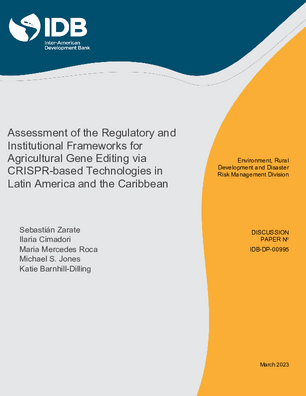Assessment of the Regulatory and Institutional Framework for Agricultural Gene Editing via CRISPR-based Technologies in Latin America and the Caribbean
Date
May 2023
Genome editing tools have promised tremendous opportunities in agriculture for breeding crops and livestock across the food supply chain. Potentially addressing issues associated with a growing global population, sustainability concerns, and possibly helping address the effects of climate change (Kuiken, Barrangou, and Grieger 2021). These promises come alongside environmental, cultural, and socio-economic risks. Including concerns that governance systems are not keeping pace with technological developments and are ill-equipped, or not well suited to evaluate risks new genome editing tools may introduce. Understanding these complex, dynamic interactions across the LAC region is important to inform appropriate and acceptable regional governance and investment strategies.
The power and promise of gene editing, CRISPR specifically, were first realized with the discovery of CRISPR loci in the 1980s (Anzalone, Koblan, and Liu 2020). Since that time, CRISPR-Cas systems have been further developed enabling genome editing in virtually all organisms across the tree of life (Anzalone, Koblan, and Liu 2020). Gene editing is not a singular technology or technique; it refers most often to a set of techniques that enable the manipulation of a genome with greater precision than previous iterations of genetic engineering (Shukla-Jones, Friedrichs, and Winickoff 2018b).
The Inter-American Development Bank partnered with North Carolina State Universitys Genetic Engineering and Society (GES) Center to assess the regulatory and institutional frameworks surrounding gene-editing via CRISPR-based technologies in the Latin America and Caribbean (LAC) regions. The project studied the following core components:
Current Policy Evaluation:
Understanding what the future may hold requires a critical examination of the current status of the regulatory landscape. Analysis of the existing regulatory systems for agricultural biotechnologies throughout Latin America and how they included considerations for novel biotechnology strategies such as gene editing through CRISPR technologies were done.
Forecasting and Future Policy Scenario Analysis:
Potential products created through gene editing may face very different situations on the ground, depending on countries diverse regulations and market structures. To clarify the potential impacts of regulatory reforms, we included concrete case studies in our analysis.
Identifying investment priorities:
The diversity of the region naturally means that countries will have unique priorities and needs with respect to investment in agricultural biotechnology development and regulatory infrastructure. The document evaluates the accomplishments of the region in the development of gene edited products, highlighting both private and public sector innovations.
The power and promise of gene editing, CRISPR specifically, were first realized with the discovery of CRISPR loci in the 1980s (Anzalone, Koblan, and Liu 2020). Since that time, CRISPR-Cas systems have been further developed enabling genome editing in virtually all organisms across the tree of life (Anzalone, Koblan, and Liu 2020). Gene editing is not a singular technology or technique; it refers most often to a set of techniques that enable the manipulation of a genome with greater precision than previous iterations of genetic engineering (Shukla-Jones, Friedrichs, and Winickoff 2018b).
The Inter-American Development Bank partnered with North Carolina State Universitys Genetic Engineering and Society (GES) Center to assess the regulatory and institutional frameworks surrounding gene-editing via CRISPR-based technologies in the Latin America and Caribbean (LAC) regions. The project studied the following core components:
Current Policy Evaluation:
Understanding what the future may hold requires a critical examination of the current status of the regulatory landscape. Analysis of the existing regulatory systems for agricultural biotechnologies throughout Latin America and how they included considerations for novel biotechnology strategies such as gene editing through CRISPR technologies were done.
Forecasting and Future Policy Scenario Analysis:
Potential products created through gene editing may face very different situations on the ground, depending on countries diverse regulations and market structures. To clarify the potential impacts of regulatory reforms, we included concrete case studies in our analysis.
Identifying investment priorities:
The diversity of the region naturally means that countries will have unique priorities and needs with respect to investment in agricultural biotechnology development and regulatory infrastructure. The document evaluates the accomplishments of the region in the development of gene edited products, highlighting both private and public sector innovations.




